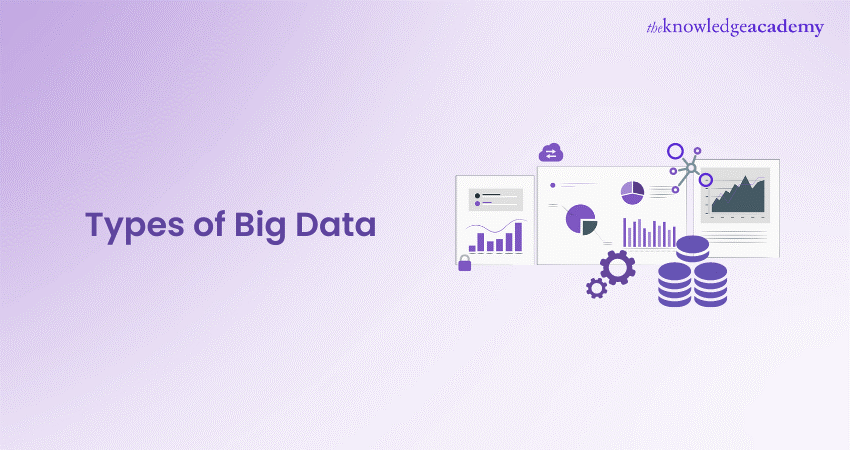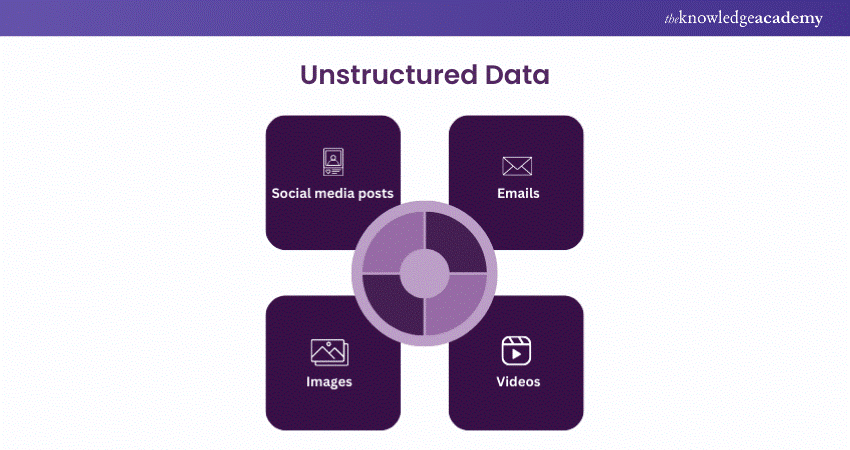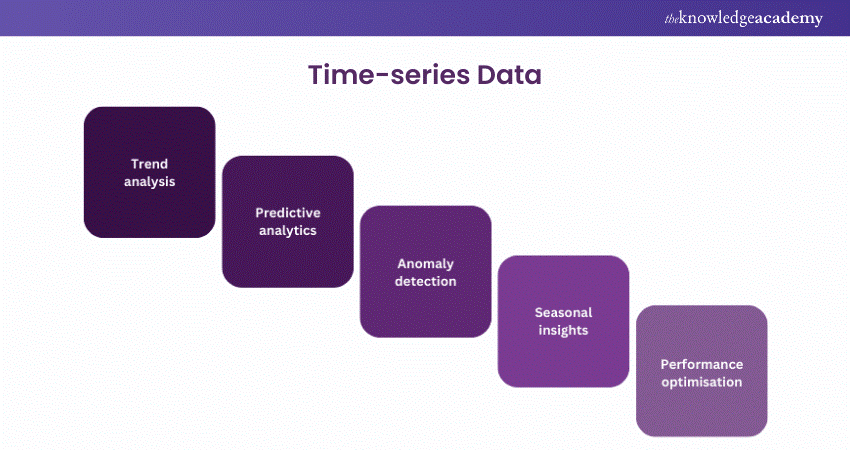We may not have the course you’re looking for. If you enquire or give us a call on +44 1344 203 999 and speak to our training experts, we may still be able to help with your training requirements.
Training Outcomes Within Your Budget!
We ensure quality, budget-alignment, and timely delivery by our expert instructors.

Drowning in a sea of data? In today's digital age, businesses are inundated with vast volumes of information. But not all data is created equal. Understanding the different types of big data is crucial for unlocking valuable insights and making informed decisions. Is it structured, unstructured, or something in between?
This blog serves as your compass, guiding you through the diverse Types of Big Data. Discover the characteristics, challenges, and opportunities presented by each type. Whether you're a data scientist or a business leader looking to harness the power of data, this blog will equip you with the knowledge to make informed decisions and extract meaningful insights. Let's dive in and explore the world of Big Data together!
Table of Contents
1) Understanding Big Data
2) Types of Big Data
3) Importance of Categorising Big Data
4) Characteristics of Big Data
5) Conclusion
Understanding Big Data
At its core, Big Data refers to vast and complex datasets that surpass the capabilities of traditional data processing methods. These datasets are generated from diverse sources such as social media interactions, online transactions, sensor data, and more. The defining characteristics of Big Data are its enormous volume, high velocity, and wide variety.
The sheer capacity of Big Data allows for the storage of massive amounts of information. The velocity refers to the speed at which data is generated and processed. The variety indicates the different types of data, including structured, unstructured, and semi-structured formats. Collectively, these attributes make Big Data a powerful tool for gaining insights and driving decision-making across various industries.
Types of Big Data
Big Data is a term that encompasses an enormous and diverse collection of datasets generated from various sources. It is characterised by its volume, velocity, and variety, and understanding the different Types of Big Data is essential for effectively managing and analysing this wealth of information. Let's explore the Big Data types in detail:
1) Structured data
Structured data refers to well-organised, easily identifiable information that follows a fixed schema. Typically stored in relational databases, this data can be queried and analysed using conventional data management tools. Businesses and organisations widely use structured data to store critical information such as customer details, financial records, and inventory data. By organising information into rows and columns, structured databases enable efficient data retrieval and management.
Example:
Consider an online retail store's customer database. Here, each customer's information is organised into well-defined fields like customer ID, name, email address, shipping address, and purchase history. This structured format, stored in a relational database, allows the store to easily retrieve specific customer details, track purchase behaviour, and conduct analytics for targeted marketing campaigns.
Structured data, the most familiar type of data, has been utilised in traditional databases and spreadsheets for decades. Its high organisation makes it easy to search, sort, and analyse. However, its limitation lies in handling large volumes of unstructured data, which it cannot efficiently manage.
2) Unstructured Data
Unstructured data is a crucial type of Big Data that lacks a predefined structure and does not conform to traditional databases. It encompasses a wide range of information, including social media posts, emails, images, videos, and audio files.
Analysing unstructured data presents challenges due to its diverse formats, requiring specialised tools and techniques. As a significant component of Big Data, unstructured data is growing exponentially with the rise of social media and multimedia content.
Example:
Social media platforms generate vast amounts of unstructured data daily. Tweets, Facebook posts, Instagram photos, and YouTube videos are all examples of unstructured data. This data does not follow a fixed format and often includes a combination of text, pictures, and videos. Analysing unstructured data from social media enables companies to understand customer sentiments, monitor brand reputation, and identify emerging trends.

One of the main challenges with unstructured data is the need for advanced data processing and analytics methods. Techniques such as Natural Language Processing (NLP) and machine learning are often employed to extract meaningful insights. Additionally, the storage and management of unstructured data require more sophisticated systems compared to structured data.
3) Semi-structured Data
Semi-structured data combines elements of both structured and unstructured data. It has some level of organisation, typically through tags or markers, but does not adhere to rigid schemas. Common examples of semi-structured data include XML files and JSON documents. This type of data is flexible, making it suitable for storing information with varying attributes that can be nested or repeated.
Example:
Semi-structured data is prevalent in web-based forms and online surveys. These forms may contain predefined fields but also allow users to add additional comments or information, creating a semi-structured dataset. This flexibility enables organisations to collect valuable data without enforcing strict data entry rules.
Semi-structured data offers the benefits of both structured and unstructured data. It allows for greater flexibility in data organisation, making it easier to adapt to changing data requirements. Additionally, semi-structured data is more scalable than structured data and can accommodate a wider range of data types.
Machine-generated Data
Machine-generated data is produced by sensors, devices, and machines, often associated with the Internet of Things (IoT). This type of data provides valuable insights into device performance, usage patterns, and environmental conditions. Machine-generated data is generated continuously and in real time, and it plays a crucial role in optimising processes, detecting anomalies, and enabling predictive maintenance.
Example:
Internet of Things (IoT) devices generate machine-generated data continuously. For instance, smart sensors in manufacturing equipment can collect data on temperature, pressure, and vibration. This data is crucial for predictive maintenance, as it enables businesses to monitor machine health in real-time, detect anomalies, and prevent equipment failures.
Machine-generated data is an integral part of Industry 4.0 and the digital transformation of industries. It provides valuable information about the performance and health of machines, allowing organisations to optimise operations, reduce downtime, and enhance overall efficiency. The massive volume and real-time nature of machine-generated data present unique challenges in terms of storage, processing, and analysis.
Human-generated Data
Human-generated data is actively created by individuals through their interactions with digital platforms. It includes social media posts, online reviews, customer feedback, and other user-generated content. Human-generated data plays a significant role in understanding customer preferences, behaviour, and sentiments.
Example:
Customer reviews and feedback on e-commerce websites are examples of human-generated data. Customers actively contribute their opinions and experiences with products and services, providing valuable insights for businesses to improve their offerings and understand customer preferences.
Human-generated data provides a direct link to customer sentiments and preferences, making it a valuable source of information for businesses seeking to enhance their products and services. Analysing human-generated data requires advanced natural language processing and sentiment analysis techniques to derive meaningful insights.
Time-series Data
Time-series data consists of a sequence of data points recorded at successive time intervals. It is essential for analysing trends, patterns, and changes over time. Time-series data finds applications in various fields, such as finance, climate science, and industrial monitoring. Analysing time-series data can provide valuable insights into historical patterns and help predict future trends.

Example:
Weather stations collecting temperature, humidity, and precipitation data at regular intervals create time-series data. Analysing this data allows meteorologists to forecast weather patterns accurately, helping communities prepare for extreme weather conditions. In finance, time-series data is used for stock market analysis and predicting market trends. The use of time-series forecasting models like ARIMA and LSTM has become prevalent in various industries to make data-driven choices based on historical trends.
Time-series data poses unique challenges in terms of handling temporal dependencies and seasonality. It requires specialised analytical techniques to extract meaningful patterns and insights from the data. Moreover, the storage and processing of large-scale time-series data require sophisticated infrastructure and technologies.
Master big data analysis for business insights with our Big Data Analysis Training – Sign up now!
Geospatial Data
Geospatial data comprises location-based information obtained from GPS, satellites, and geographic sources. It is essential for applications such as mapping, navigation, urban planning, and location-based services, helping organisations visualise and analyse data in relation to specific geographical locations.
Example:
Ride-sharing apps like Uber or Lyft use GPS data to provide real-time geospatial information. This data helps drivers navigate efficiently, optimise routes, and provide accurate arrival times for passengers.
Geospatial data has diverse applications across multiple industries. In urban planning, it aids in analysing population distribution, traffic patterns, and infrastructure development. In agriculture, geospatial data is used to monitor crop health and soil moisture levels, enabling informed decisions for crop management.
Additionally, geospatial data is crucial in disaster management and emergency response by providing real-time information about affected areas.
Understanding the different types of Big Data is vital for organisations aiming to harness this vast resource. Each type presents unique challenges and opportunities, requiring the right tools and analytical techniques to extract meaningful insights and make informed decisions.
As the world continues to generate exponential amounts of information, the ability to effectively manage and analyse Big Data will be a key driver of innovation and success across industries.
Importance of Categorising Big Data
Categorising Big Data is a vital step in data management that brings order to vast amounts of information. By organising and classifying data into meaningful categories, businesses can unlock its true value and make more informed decisions. Here's why categorising Big Data is essential:
1) Enhanced Data Organisation
Categorisation organises data into logical groups based on common attributes, characteristics, or themes. This structured approach enables data scientists, analysts, and decision-makers to efficiently locate and access relevant information, saving time and resources by avoiding the need to sift through massive amounts of unorganised data.
2) Improved Data Analysis
Breaking down Big Data into manageable categories simplifies analysis. Analysts can focus on specific datasets, uncovering insights and patterns more effectively. This targeted analysis leads to a deeper understanding of trends and behaviours, helping businesses identify opportunities and address challenges proactively.
3) Effective Decision-making
Categorised data provides a clear framework for decision-making. Decision-makers can quickly access relevant data, evaluate different categories, and gain a comprehensive view of the organisation's performance. This data-driven approach helps businesses stay agile and responsive in a rapidly changing environment.
4) Personalised Customer Experiences
Categorising customer data allows businesses to personalise experiences for their target audience. By understanding customers' preferences, behaviours, and purchasing habits, companies can tailor marketing campaigns and offerings, resulting in higher customer satisfaction and loyalty.
5) Data Security and Compliance
Categorisation aids in data security and compliance efforts. Sensitive data can be classified and protected appropriately, reducing the risk of unauthorised access or data breaches. Additionally, compliance with regulations becomes more manageable when data is categorised and easily identifiable.
6) Optimised Resource Allocation
Categorising data helps organisations optimise resource allocation. By identifying the most critical data categories, businesses can strategically allocate resources to focus on areas with the highest impact on their goals.
7) Predictive and Prescriptive Analytics
Categorised data forms the foundation for advanced analytics, including predictive and prescriptive analytics. Predictive models can be built using historical data from specific categories, enabling businesses to forecast future trends and make proactive decisions. Prescriptive analytics utilises categorised data to recommend the best course of action to achieve desired outcomes.
Transform your business with big data architecture with our Big Data Architecture Training – Sign up today!
Characteristics of Big Data
To grasp Big Data, categorise it by the five Vs: volume, variety, velocity, value, and veracity. These characteristics help you manage and analyse large, fragmented data efficiently.
1) Volume
Volume refers to the massive size of data, often in petabytes or exabytes. Think of Instagram or Twitter, where users constantly post, comment, and like. These platforms generate enormous amounts of data daily, necessitating advanced processing technology far beyond typical computer capabilities. This vast volume of data holds immense potential for analysis, pattern recognition, and more.
2) Variety
Variety involves different data types and formats from various sources like Facebook, Twitter, Pinterest, Google Ads, and CRM systems. This data can be structured, semi-structured, or unstructured, including text, images, videos, and more. The diversity in data types requires sophisticated tools and techniques to collect, store, and analyse effectively.
3) Velocity
Velocity is the speed at which data is generated and processed, often in real-time. The rapid accumulation of data demands systems capable of handling high-speed data streams. For instance, real-time data processing is crucial for applications like financial trading, where timely decisions are essential. The faster the data is processed, the more up-to-date and relevant the insights will be.
4) Value
Value emphasises the importance of processing valuable and reliable data to gain insights. It’s not just about the quantity of data but its quality and relevance. Valuable data can drive informed decision-making, uncover trends, and provide competitive advantages. Ensuring data is meaningful and actionable is key to leveraging its full potential.
5) Veracity
Veracity focuses on the trustworthiness and quality of data, ensuring its reliability for analysis. High-quality data is accurate, consistent, and trustworthy. This is especially critical when dealing with real-time data, where inaccuracies can lead to flawed insights and decisions. Implementing checks and balances at every stage of data collection and processing helps maintain data integrity and reliability.
Conclusion
We hope you read and understood the different Types of Big Data. Understanding them is crucial for leveraging their potential. From structured to unstructured, machine-generated to human-generated, each type offers unique insights. Embracing Big Data's complexities empowers businesses for data-driven success.
Empower your expertise in big data and analytics with our Big Data and Analytics Training –Sign up now!
Frequently Asked Questions

Big Data enables businesses to uncover trends, optimise operations, enhance customer experiences, and make data-driven decisions, leading to improved efficiency and competitive advantage.

Big Data is managed using advanced storage solutions and analysed with tools like Hadoop, Spark, and Machine Learning algorithms to extract insights, identify patterns, and support decision-making processes.

The Knowledge Academy takes global learning to new heights, offering over 30,000 online courses across 490+ locations in 220 countries. This expansive reach ensures accessibility and convenience for learners worldwide.
Alongside our diverse Online Course Catalogue, encompassing 17 major categories, we go the extra mile by providing a plethora of free educational Online Resources like News updates, Blogs, videos, webinars, and interview questions. Tailoring learning experiences further, professionals can maximise value with customisable Course Bundles of TKA.

The Knowledge Academy’s Knowledge Pass, a prepaid voucher, adds another layer of flexibility, allowing course bookings over a 12-month period. Join us on a journey where education knows no bounds.

The Knowledge Academy offers various Big Data & Analytics Courses, including Hadoop Big Data Certification Training, Apache Spark Training and Big Data Analytics & Data Science Integration Course. These courses cater to different skill levels, providing comprehensive insights into Key Characteristics of Big Data.
Our Data, Analytics & AI Blogs cover a range of topics related to Big Data, offering valuable resources, best practices, and industry insights. Whether you are a beginner or looking to advance your Big Data Analytics skills, The Knowledge Academy's diverse courses and informative blogs have got you covered.







 Top Rated Course
Top Rated Course




 If you wish to make any changes to your course, please
If you wish to make any changes to your course, please


